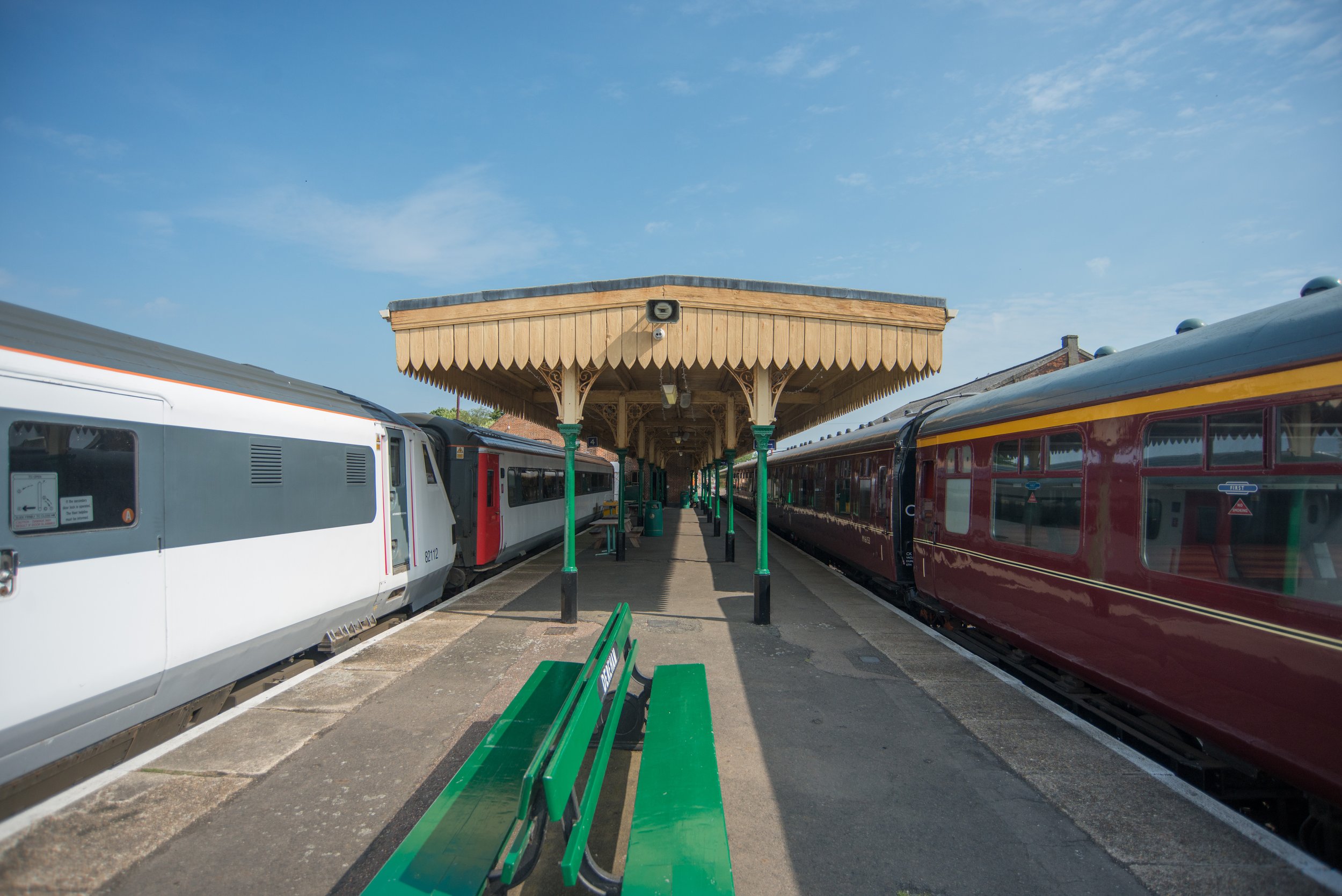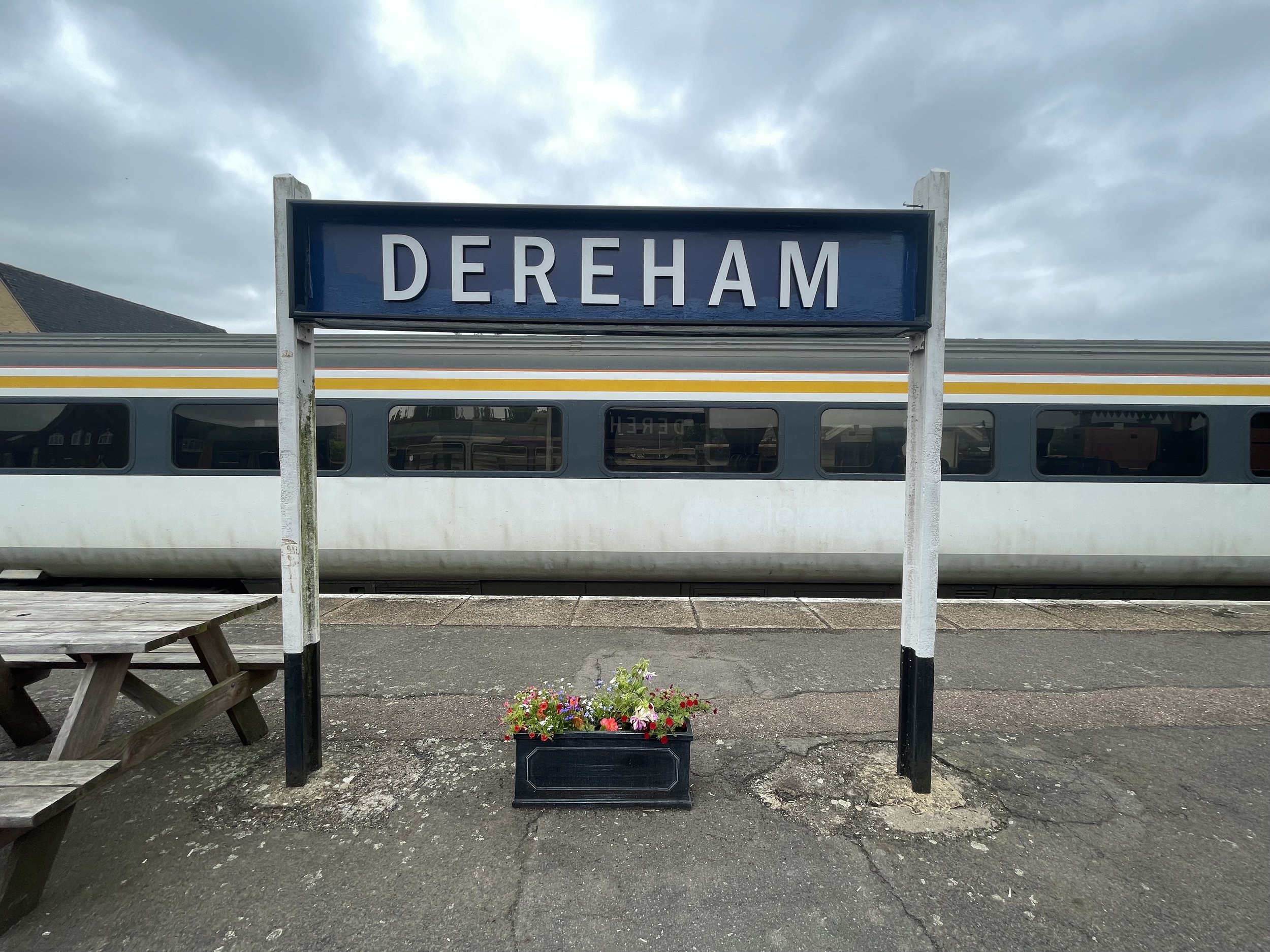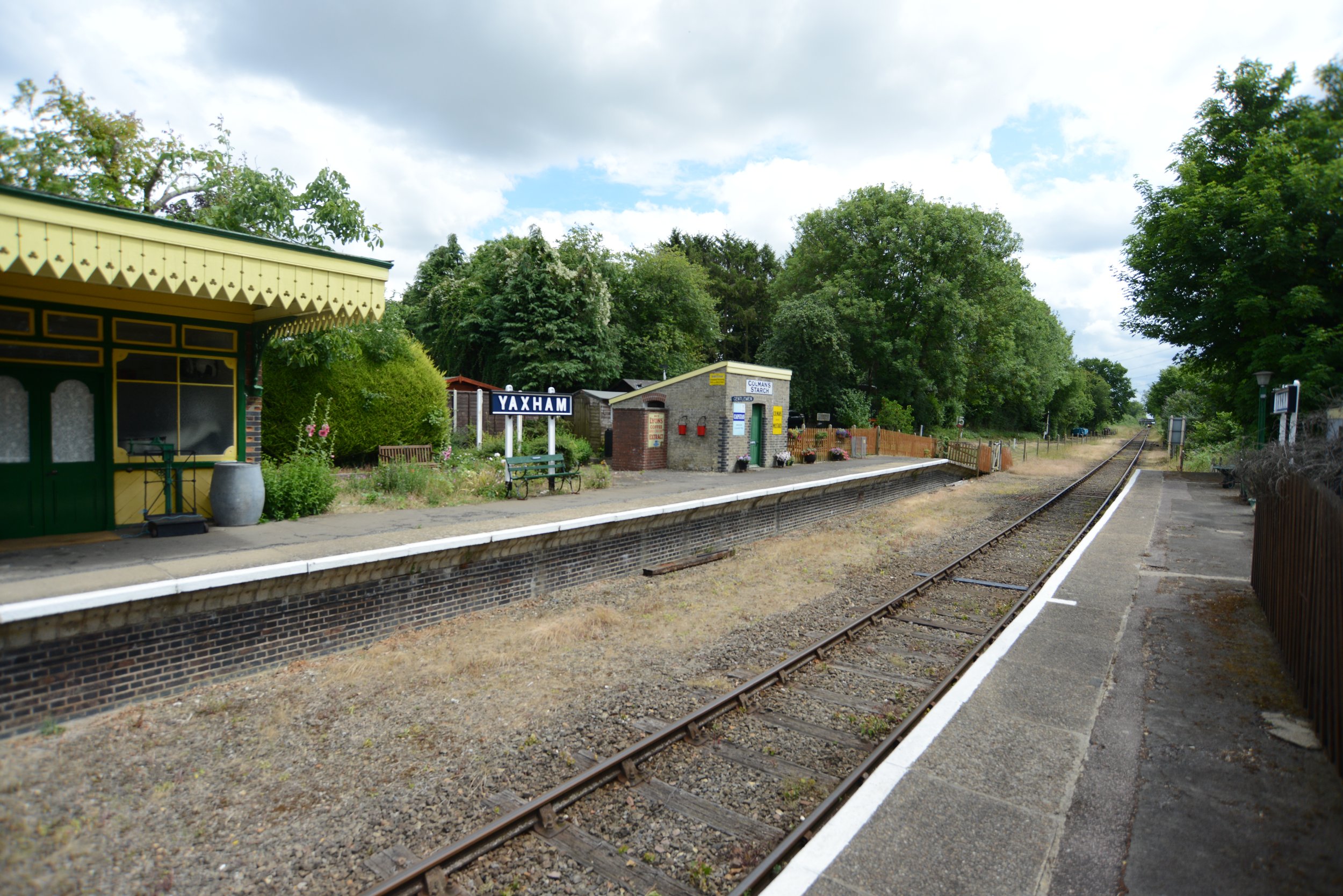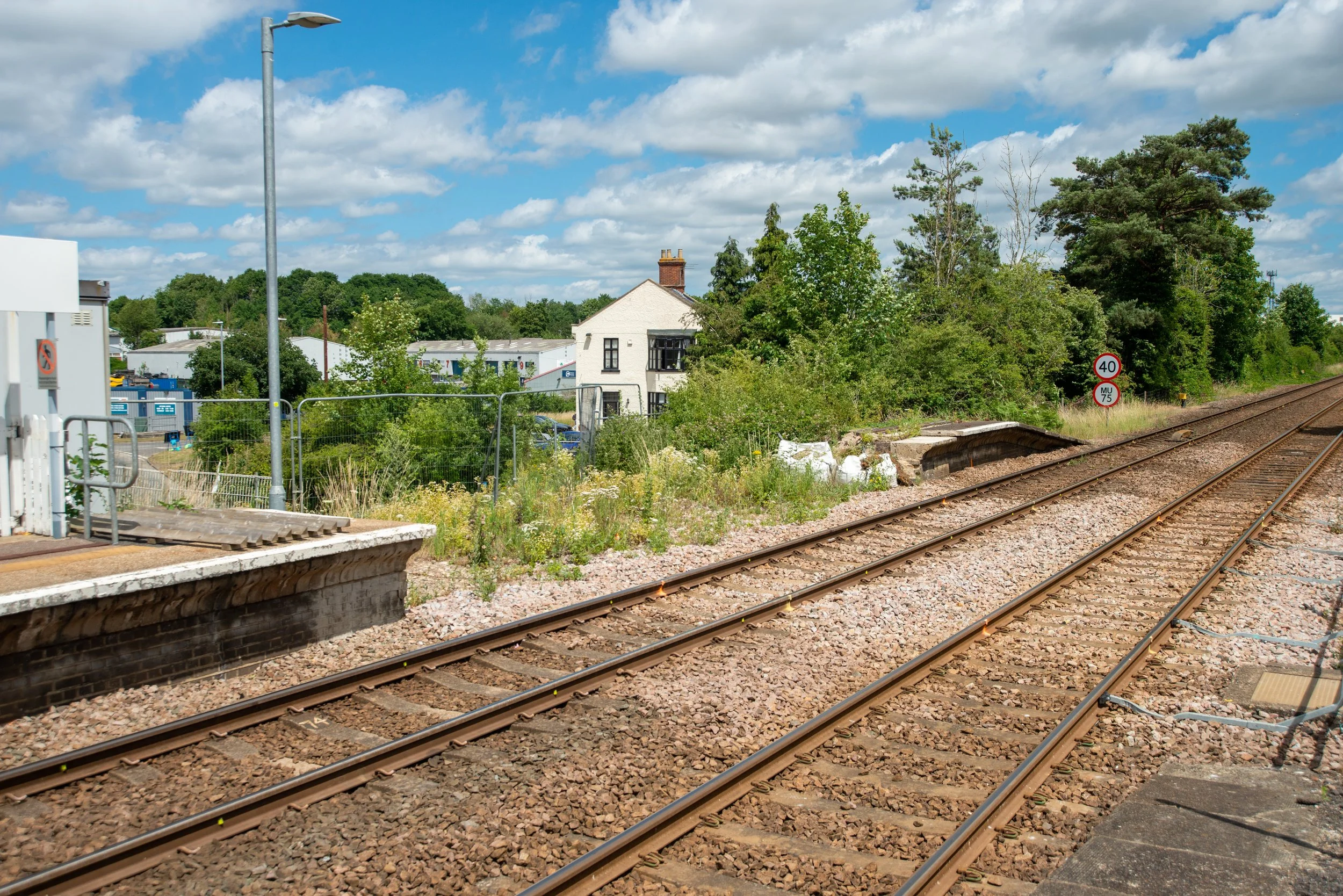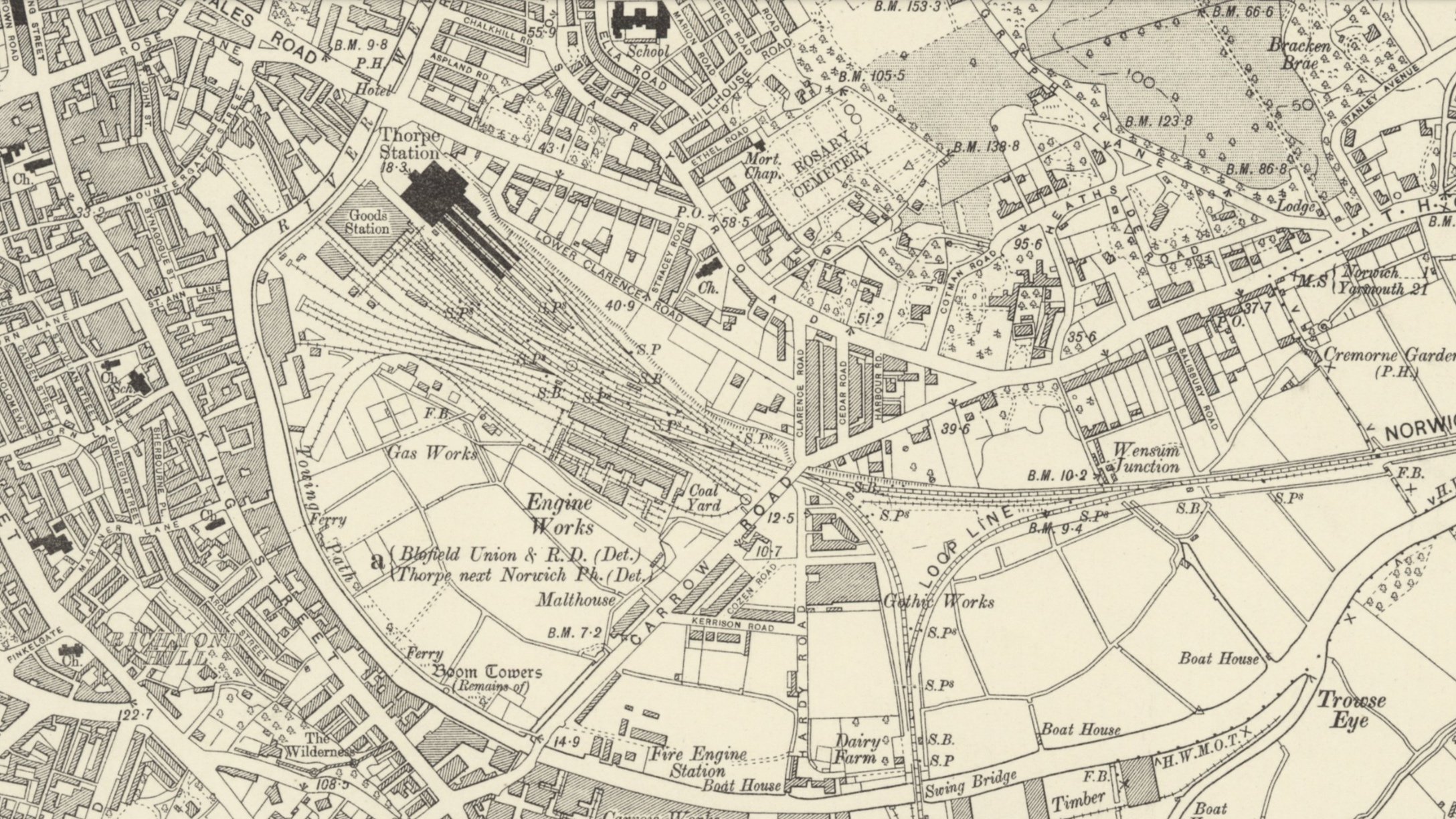DEREHAM TO NORWICH

The past
The Lynn Dereham railway company had plans to extend their railway beyond Dereham towards Norwich and Great Yarmouth. However, in 1845, Parliament decreed that the line should not be built by the Lynn Dereham company. As a result, the Norfolk railway company was formed and they built the railway from Dereham to Wymondham. They then used the existing line from Wymondham to continue on to Norwich, the Capital city of Norfolk, via a junction at Wymondham.
The line between Wymondham and Norwich is called the Breckland Line and runs from Norwich To Ely. It was opened in 1845 and is 51 miles 8 chains (82.2 km) long.
By 1846, the line was nearing completion, not without incident, as there was an accident at the Wicklewood Bridge, leaving sadly many workers badly injured and burned.
Passenger services began on February 15, 1847, following the opening of the Dereham to Wymondham freight line on December 7, 1846.
It wasn't until 11 September 1848 that the line from King's Lynn finally reached Dereham.
In 1857 the line between Dereham and Wells opened. The entire line then became part of the Great Eastern Railway in 1862
The distance between Dereham and Wymondham was 11-1/2 miles
In the early 1880s, the railway line between Dereham and Wymondham was expanded to a double-tracked line, which was completed shortly after 1882. Yakham, Thuxton, Hardingham, and Kimberley Park all had new platforms constructed on the new up line, while the down line platforms underwent alterations, including the addition of new canopies.
Trains travelling from Dereham would sometimes reverse and head west towards King's Lynn via Swaffham. In 1886, an avoiding double track line was constructed to the south of the Dereham station. This allowed the Wymondham to King's Lynn line to be used as a cross-country route. The avoiding line was utilised by freight, excursion, and diverted main-line trains.
The 1955 Modernisation Plan introduced diesel trains on the line. However, as car usage increased by the 1960s, the line faced closure under the Beeching cuts.
In June of 1965, the section between Wymondham and Dereham was reduced to a single track, with a passing loop located at Hardringham.
Although it was recommended to keep the line open for freight and express trains, it eventually closed in October 1969. The Wells branch had already closed in 1964, and the Lynn branch in 1968.
The line closed to Freight in 1989
Trains would call at
Yaxham
Thuxton
Hardingham
Kimberley Park
Wymondham
Norwich Thorpe
The Present
The 11’5 miles of track in between Dereham and Wymondham are now owned by the Mid Norfolk Heritage Railway, with also part of the old track bed from Dereham to County school that they plan to open in the future. The Mid Norfolk railway have ran few special services to Hoe Crossing from Dereham that was part of the Dereham to Wells via Fakenham line.
The Mid Norfolk Railway runs a line that consists of single-lined sections with passing points along the route. There is also a storage facility at Kimberly Park that was constructed to store new Class 745 and 755 Greater Anglia stock before these trains entered service. The sidings are still used today for storage, as well as for heritage and other rolling stock.
The Mid Norfolk Railway does not run all the way to Wymondham. It stops just outside the junction of the still-in-use Norwich to Cambridge Breckland line junction at a new station called Wymondham Abbey that was opened in 1999.
The Mid Norfolk plans to open a new station closer to Wymondham in time.
In terms of passenger service, the Dereham (Rashers Green)to Yaxham route reopened in 1995, followed by the reopening of Dereham railway station in 1997. Finally, the Dereham to Wymondham section reopened to passengers in 1999.
The Mid Norfolk still Runs Heritage services along the line with the popular Polar Express Christmas service.
Wymondham to Norwich.
The Breckland line.
The Breckland line opened in 1845 and is 51 miles 8 chains (82.2 km) from Ely.
In 1844, the Norwich to Brandon Railway Company was established with the aim of constructing a railway that would connect Norwich and Brandon. At the same time, the Eastern Counties Railway Company was building a line from Essex to Brandon via Ely. This route provided the first access to London before the Great Eastern Mainline was constructed in 1862. The Great Eastern Mainline offered a more direct and faster route from Norwich to London Liverpool Street.
Shortly before Opening the line the Norwich to Yarmouth company and the Norwich Brandon Railway company was taken over by the Norfolk Railway Company by the 1860s the line was taken over by the Great Eastern Railway Company. Later, in 1923, it was acquired by LNER, which was then followed by British Railways.
The trains from Dereham travelled along the Breckland line entering via a junction just to the South West of the Station, stopping only at Wymondham. Just before Trowse Newton, the line merged with the Great Eastern mainline via a junction and crossed the Trowse Swing bridge before arriving at Norwich Thorpe station.
The Breckland line passes through Norfolk, Suffolk, and Cambridgeshire on its way to Ely and Cambridge, stopping at Spooner Row, Attleborough, Eccles Road, and Harling Road. The next station after Harling Road would have been Roudham Junction railway station, which linked up Thetford to Swaffham via the Bury and Thetford (Swaffham Branch) Crab and Winkle line. This line called at Wretham and Hockham, Stow Bedon, Watton, Holme Hale, and then onto a junction just outside Swaffham, before joining the King’s Lynn to Dereham Line. Unfortunately, this part of the line closed between Roudham Junction and Swaffham in 1964 under the Beeching cuts. Roudham station also closed in 1964. You can find more information on this line on this website's Swaffham to Fransham page.
The rail line, after passing through Roudham Junction, stopped at Thetford and Brandon, which lies on the border of Norfolk, and then moved into Suffolk, stopping at Lakenheath Shippea hill. This station is known for being one of the least used stations in the country, having recorded the lowest number of passengers twice in a row in 2014 and 2015-2015 2016. In 2014-2015, it recorded only 12 passengers; in 2015-2016, it recorded 22 passengers. After Shippea hill, the Breckland line reaches Ely in Cambridgeshire and joins the Fen Line, which connects King's Lynn to Cambridge and London King's Cross and London Liverpool Street.
The Breckland line is still operational today, offering services from Norwich Thorpe to Ely. At Ely, there is a junction on the Fenline that provides services via Downham Market to King’s Lynn, which was also the starting point of the Lynn Dereham Line. The Wymondham junction is still in use for heritage railway purposes and storage at Kimberly Park. After Ely, the services continue mostly passing through Waterbeach with some peak time services stopping before heading off to to the newly constructed Cambridge North and main Cambridge station, with most services also going to Stanstead Airport. The majority of services on this line are offered by Greater Anglia, which provides services from Norwich to Cambridge and Stanstead Airport, and East Midland Railway, which goes via Ely to Manchester and Liverpool.
Google Maps coverage
Seen on Google maps below the Dereham to Norwich map coverage.The lines in yellow are the Dereham to Norwich line, and the lines in blue are junctions and other routes.

DEREHAM STATION
Dereham station was built in stages over several decades. It has four platforms, with platforms 2 and 3 being set back to back. Platform 4 is a short bay platform that was initially dedicated to trains heading towards King's Lynn. Dereham used to have several signal cabins that controlled the freight yards in the area. The central signal box and the west signal box are still present as part of the Mid Norfolk railway. The main goods shed was located behind the up platforms. There were also many sidings in Dereham that were used for local mills and agriculture. The up-and-down platforms were connected by a steel footbridge, but it no longer exists. Dereham also had its own Turntable. The Dereham loco sheds closed in 1955 for steam use and were used to stable DMU trains until 1968; they were then demolished, and the land is now used as a leisure centre. In 2020, a smaller shed was built with funds from the EU on the part of the site of the old shed. The Beeching report intended to keep the Lynn Dereham Norwich route. Despite this, the King's Lynn part was closed in 1968 and the rest to Wymondham was closed in 1969. Services to Wells from Dereham had already closed as early as 1964. Freight services carried on in use to Fakenham East until 1980. The station closed down in the mid-80s and was left to the elements.
The station was reopened in 1997 by the Mid-Norfolk Railway Preservation Trust.
Dereham Historical Maps
Thanks to the National Library of Scotland, historical maps show Dereham station with the avoiding line.
©Nãtional Library of Scotland.
Leaving Dereham for Norwich
Trains leaving Dereham for Norwich would either reverse towards Norwich or travel down the double-track avoiding line from King’s Lynn before heading off towards Norwich.
Some Stock on the Mid Norfolk Railway
Leaving Dereham, heading towards Yaxham.
Leaving Dereham, the railway crossed over the River Tudd before it arrived at the next station, Yaxham.
Yaxham station
Yaxham was the first station after Dereham, located 28 miles and 35 chains away from King's Lynn. It was about two miles away from Dereham. The station was opened in 1847 and initially had a single platform. However, with time, the line was doubled and another platform was added to the up line at Yaxham. Yaxham station had two platforms, as well as goods yards and a goods shed. The waiting room had a large glass front, and there was a two-story station master's house. Additionally, there was a signal box at Yaxham, which had a 26-lever frame and was attached to the waiting room. The level crossing was located just beside the signal box.
Yaxham closed in 1969 and reopened on 26 July 1997 as part of the Mid Norfolk Railway.
Yaxham station still exists today and is now part of the Mid Norfolk Railway Heritage Railway. The Yaxham Light Railway is also located there. The Yaxham signal box is the only original signal box left on the heritage railway. The waiting rooms on the up platform are still standing, while the waiting rooms on the down platform have been demolished.
The down platform remains the only operational platform, with the track laid on the Up side having been removed and there is no passing place located here at Yaxham.
The station master's house and railway hotel are both still standing and privately owned. The brick-built goods shed is located away from the railway and is being used as a shed for a renovation company that is working on steam engines.
I visited this station in June 2022 while on a pacer day.
Yaxham station in June 2022
The railway line departed from Yaxham and made its way towards its next stop, Thuxton. It went through cuttings and crossed an embankment, passing near the villages of Whinburgh and Garveston. Due to both Whinburgh and Garveston being located close to Yaxham or Thuxton, no stations served them. However, Garveston does have a level crossing that is still being used on the Mid Norfolk Railway.
Thuxton station
Thuxton is the second station after Dereham, roughly 30 miles away from King's Lynn.
The station was opened in 1847 and initially had a single platform. However, with time, the line was doubled, and another platform was added to the up line at Thuxton.
Thuxton, once the line was doubled like many other stations, had waiting rooms with glass-fronted designs also added.
Thuxton is a small station located between Dereham and Norwich. It has a level crossing south of the platforms, and the main station buildings are situated on the down side, which includes a two-story station master's house.
Thuxton had a goods siding but no shed, and the signal box became a ground frame by 1933.
Thuxton station reopened in 1997 as a request stop, and later became a full-time stopping station.
Thuxton is now a part of the Mid Norfolk Railway. In 2010, a passing loop was reinstated, which returned the station to double track. During my many visits to Thuxton, Mid Norfolk services terminate here due to bridge damage down the line, which stopped the services from running any further as the only passing place was here at Thuxton.
A new signal box has been built at Thuxton using parts from the old signal box at East Winch. The design is based on the signal box from the Breckland line at Shipea Hill, which runs from Norwich to Ely via Wyndomham.
The lever system here is a McKenzie and Holland lever frame that was saved from Seven Sisters signal box in North London.
The Mid Norfolk Railway Volunteers at Thuxton have done an amazing job of re-doubling the line and renovating the station to a high standard, which I have photographed.
"I would like to express my gratitude to all the volunteers present here. Thank you very much for your dedication and hard work."
Hardingham Station
Hardingham station is located around 32 miles and 34 chains away from King's Lynn. Like all other stations, it was opened in 1847 as a single platformed station. In the early 1880s, the line was doubled and a new platform was built for Hardingham. The station has a 21-lever signal box and an L-shaped two-story station master's house with waiting rooms on the up platforms. There was a goods yard on the downside with two sidings available.
Hardingham also had a Turn Table supplying 3 small spurs.
Hardingham was kept as a passing loop until the passenger services ended in October 1969, after which the branch was singled in June 1968.
In the present time, Hardingham station is on the Mid Norfolk railway even though it's not on the regular timetable and trains only stop on rare occasions. such as gala days.
Between 2018 and 2019, a project was initiated to relocate parts of the double track to provide storage for the new Greater Anglia trains. The track was moved southwards towards Kimberly Park, and the second platform was restored.
The signal box at Hardingham originates from the King's Lynn to Hunstanton Great Eastern railway station at Snettisham. The current owners have beautifully restored it.
Passing Hardingham station, Mid Norfolk Railway by roger geach Creative Commons Attribution-Share Alike 2.0 Generic
After departing from Hardingham, the train continued towards its next stop at Kimberley Park. It traversed through several cuttings, embankments, crossed over a bridge and entered Kimberley Park.
The now single-track bed looking towards Hardingham from Kimberley Park crossing.
Kimberley Park station
Kimberley Park is a station located 34 miles and 17 chains away from King’s Lynn. It was initially known as "Kimberley" until 1923 when it was renamed to Kimberley Park due to confusion with another station in Nottinghamshire. The station was opened in 1847 as a single-platform station. In the early 1880s, the line was doubled and Kimberley Park gained another platform on the up side, along with a small waiting room. Most of Kimberley Park's main infrastructure, including the station master's house and the larger waiting room with a typical glass front, was situated on the downside. Additionally, a canopy was added to the platform in the early 1800s. Kimberley Park had a single goods siding on the downside of the line. Cattle pens were also present, but there was no goods shed available.
At the southern end of the down platform once sat the station's signal box, which is now demolished.
In the past few years, Kimberley Park has been done up to a very high standard and is a request stop on the Mid Norfolk railway.
A Victorian image showing the doubling of the railway line through Kimberley station, Norfolk, around 1881.
Sourced via Wikipedia-Copyright Public domain.
Kimberley Park 1998
© Copyright Ben Brooksbank and licensed for reuse under this Creative Commons Licence.
Kimberley Park station 2025
Kimberley Park Signal Box.
© Copyright photographer and year unknown
Remains of Kimberly Park’s signal box were photographed in January 2025 whilst the line was closed.
The train departed Kimberley Park and is now on its way to the Dereham line junction at Wymondham. From there, it will continue on the Breckland line and shortly reach Wymondham station. During the journey, it will pass through Cuttings and the village of Crownthorpe before curving around and heading towards Wymondham. On the way, the train will pass by Wymondham Abbey Church and a siding for the brush factory, which was installed in 1920. As the train approaches Wymondham South Junction, a standard Great Eastern signal box would control the junction. Finally, the train will arrive at Wymondham Down Platform on the Breckland Line.
Wymondham South Junction
Wymondham South Junction, located just southwest of the station, diverted services from the Main Breckland line to Dereham, Fakenham, and Wells when the line was operational. Today, the junction still links the Mid Norfolk railway to the Main Line. Although the signal box at Wymondham South Junction has been out of use since 2012, it remains standing.
How long the box will remain is unknown.
Wymondham station.
Wymondham station, situated on the Breckland line, was opened in 1845 by the Norfolk Railway Company. In 1847, Wymondham became the Junction station for services to Dereham, Fakenham and Wells. There were also services via Dereham to King’s Lynn. The station is located between a junction at Ely down the line and a Junction close to Trowse that goes onto Norwich Thorpe station using a short part of the Great Eastern mainline. Also, a junction close to Wymondham took services through to Forncett. This junction linked the Breckland line up to the Great Eastern mainline. The line was only 6 miles long and was opened between 1881 and 1952, with only one station along the route, Ashwellthorpe railway station, that closed to passengers in 1939.
This line connected Wymondham to Lowestoft for freight services with limited passenger trains. It provided additional travel options to London and also emergency diversions.
Wymondham is located 37 miles and 76 chains away from King's Lynn, and roughly 11 miles away from Dereham. Wymondham station has two platforms, which are connected via a lattice girder bridge. From there, you can view the South Junction signal box and junction. Three lines run through Wymondham: the up and down Breckland lines, and a third line that might be mistaken as a third line using the platform at Wymondham as an island platform. However, this third line is fenced off and used as a goods loop. The downside of the station has most of the buildings, while substantial shelters are also present on the upside. Wymondham used to have two signal boxes. During the BR period, one of the signal boxes was reduced to a ground-floor status. In 2012, the whole of the Breckland line was controlled by a signalling centre in Cambridge.
Wymondham also had a substantial goods yard on the downside, whilst sidings were also on the upside. Close to the junction to Dereham also sat a 45ft turntable but no engine sheds.
Currently, Wymondham has an hourly train service to Norwich and Cambridge, as well as Stansted Airport via a junction at Ely that connects to the Lynn Ely line. Trains to Liverpool via Peterborough also pass through.
Below are historic maps showing Wymondham station, with Dereham Junction to the left and Forncett Junction to the right.
@National Library of Scotland
The railway line, extending from Wymondham to its final destination, Norwich Thorpe, once had another station called Spinks Lane. Opened in July 1845, it was unfortunately closed just four months later in November of the same year. The reason behind its closure was that the relatively small town of Wymondham didn’t require two stations, and the Spinks Lane station wasn’t utilised frequently.
As the service passed the old site of Spinks Lane station, it continued on to Hethersett railway station. Most Dereham-Norwich services would pass through this station without stopping.
Heathersett station opened in 1845, closed in 1847, reopened in 1852, and closed to passengers in 1964 and freight in 1966.
The line soon reached a deep cutting, passing under a bridge that carried the main Norwich to London Great Eastern main line over the Breckland line. The line then joined the Great Eastern main line at Trowse Lower Junction. It then crossed Trowse swing bridge before heading into Norwich Thorpe.
A temporary terminus at Trowse was constructed in July 1845 till December 1845 whilst the Bridge was completed.
Trowse Swing Bridge is the only Swing bridge in the UK that carries an overhead electrical conductor system.

NORWICH THORPE STATION
END OF THE LINE
Norwich railway station, previously known as Norwich Thorpe, is the main railway station in Norwich. It serves as the final station for the Breckland line from Ely, the Great Eastern main line from London, and the Wherry line from Great Yarmouth, Lowestoft, and from Sheringham the Bittern line.
Most of the services are provided by Greater Anglia, with some services using the Breckland line going on to Liverpool from a junction at Ely and via Peterborough, ths service is served by East Midlands Railway at the time of writing.
Norwich Thorpe was one of three stations in Norwich; the first to open was Norwich Thorpe in 1844, the other two being.
Norwich Victoria opened in 1849, closed to passengers in 1916 and to freight in 1966, and was entirely closed in 1986 as a coal concentration depot.
Norwich City M&GN station opened in 1882 and closed in 1959 to passengers and in 1969 to freight.
Opened in 1844, Norwich Thorpe was the Western terminus of the Norwich to Yarmouth Railway.
In 1845, the Breckland Line arrived at Norwich.
In 1851, the Great Eastern Main Line arrived at Norwich.
From 1874 to 1877, the Bittern Line was extended from North Walsham to Sheringham, where it connected to the M&GN network.
In 1866, the station was rebuilt with the central dome we still see to this day with three island platforms, giving Norwich 5 platforms, with a platform being added in 1954. The line where the 6th platform now resides was previously used for shunting and stabling duties.
Most of Norwich's freight was handled at Norwich Victoria, while Norwich Thorpe had many sidings and a vast engine shed, which became the Great Eastern Railway's largest engine shed.
Also situated here, to the eastern side of the siding, sat a turntable.
The engine shed originally opened in 1843. However, it was closed down in 1982. A more modern facility was built to replace it at Crown Point, located east of the station. This new facility is arranged in a triangle formation between the wherry lines and the Great Eastern main line.
Today, the riverside complex sits where the goods sheds once stood.
Outside the station, a line called the Western Curve allowed freight trains and holiday specials to bypass the station and head towards Yarmouth, Sheringham, and other lines served by Norwich. The new Crown Point Train Maintenance Depot now sits on this curve.
Norwich Thorpe was renamed Norwich in May 1969 after the closure of Norwich City station and Norwich Thorpe being closed the station became known as Norwich and is still in daily use and managed by Network Rail.
NORWICH THORPE MAPS
PAST MAPS
©National Library of Scotland
Present Maps
Norwich engine sheds past & present.
The Western Loop, where the Crown Point Depot now stands.
Norwich Station
THANKS FOR LOOKING




